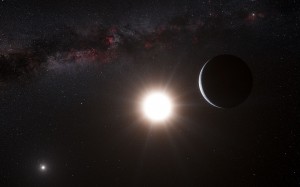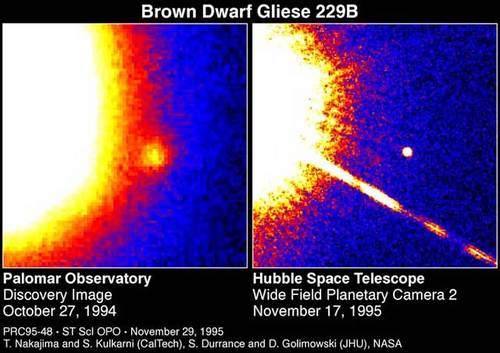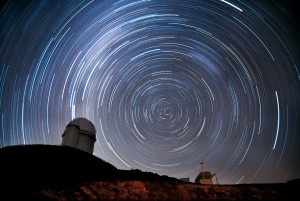
This artist’s impression shows how the planet that is orbiting the near-by star Alpha Centauri B could look like (source: ESO)
Last week, the European Southern Observatory ESO announced the finding of an Earth-sized planet around the nearby star Alpha Centauri B.
Based on measurements by spectrograph, which registers the exact location of absorption lines in the stellar spectrum as a function of time, the research team around Xavier Dumusque of the Geneva Observatory could determine the radial motion of the star as seen from the Earth. A somewhat tedious process of removing background effects from the motion of the observer (Earth rotation, Earth orbit around the Earth-Moon centre of gravity, Earth orbit around Sun), as well as any convective motion of the hot gases in the star’s outer shell yields the proper motion of Centauri B.
Here the researchers are not interested in the almost constant relative motion of the star with respect to our Solar System’s centre of gravity, but in any deviations from that. Variations of the residual radial velocity indicate the presence of a massive object in the vicinity of Centauri B. And – indeed – the research team found something! A periodic variation of the radial velocity indicated an orbiting object, much lighter than Centauri B itself.
This signature is typically interpreted as proof for the presence of an orbiting planet. The time-resolved radial velocity allows drawing conclusions about the orbital period and eccentricity, from which by means of the Keplerian laws one can discern the size and shape of the planet’s orbit around its host star. Also, the amplitude of the radial velocity variation together with the assumed Keplerian velocity of the planet (given the size of its orbit according to Kepler’s third law of planetary motion) allows drawing conclusions on the (minimum) mass of the star’s companion.
Since the radial velocity method is well established, the presence of a planet in orbit around Centauri B has already been confirmed by the IAU and its name according to the IAU designation scheme is “Alpha Centauri B b.” The planet has a mass of roughly that of Earth (based on the amount of the star’s radial motion) and its average distance from Centauri B is 4% (6 million km) of the distance between the Earth and the Sun (150 million km) – based on its orbital period.
 Now what’s so exciting about an Earth-sized planet around the star Alpha Centauri B? The excitement is about its proximity. Centuari B is ‘only’ 4.4 light-years away. It is thus the second-closest star to our Sun. The closest is Proxima Centauri, a far companion of the triple Alpha Centauri system.
Now what’s so exciting about an Earth-sized planet around the star Alpha Centauri B? The excitement is about its proximity. Centuari B is ‘only’ 4.4 light-years away. It is thus the second-closest star to our Sun. The closest is Proxima Centauri, a far companion of the triple Alpha Centauri system.
This proximity opens the door to direct imaging of the planet or other, more distant planets the system might have. While, formally, this feat has been achieved before, the only pictures of exoplanets we have thus far are giant planets orbiting very dim stars (typically brown draws). The star Alpha Centauri B represents more closely what we understand as a ‘sun’. So, there is the possibility that we soon will be able to have a direct observation of a planet around another sun.
It will not be more than one pixel in the image, so don’t expect an actual ‘picture’. Not very exciting you think? Think again!
If we analyse the light in that pixel using spectrographs, we will have in our hands the first chemical analysis of an atmosphere (if it exists) of a world outside our Solar System. What can we learn from that? Well, spectra are a treasure trove of information. Depending on the spectral resolution that we can obtain (and that in turn depends on the amount of light we can collect from that planet) atmospheric spectra contain the signatures of elements and molecules that make up the atmosphere. In zeroth-order approximation, any body at a given temperature has the spectrum of a so-called black body. For a planet, the temperature is in a range such that that the emission spectrum (that is, the spectrum of the light it emits due to its temperature) is in the infrared region of the electromagnetic spectrum.

A long-term exposure showing the La Silla Observatory, Chile, in front of the starry background (source: ESO).
Chemical compounds in the atmosphere will absorb this radiation and thus there will be intensity missing for particular wavelengths. This absorption spectrum is characteristic for the chemical compound.
Unfortunately, normally there is a mix of compounds in an atmosphere and the spectral features are overlapping. So there is the art of spectroscopy, which uses a set of laboratory measurements of spectral features of pure chemical compounds in an effort to match an observed spectrum. If we look at our neighbouring planet Mars, we find a very nice and clean spectrum of an atmosphere almost exclusively made of CO2. Compared to that, the spectrum of the terrestrial atmosphere is extremely complex. Features of water and ozone can be distinguished, but it is difficult to discriminate the various compounds. Now – with a spectral analysis of an exoplanetary atmosphere, the science of cosmochemistry will be raised to a totally different level. Suddenly (hopefully) we will be in a position to make models about the chemical processes that go on at a planet that has formed around a different star.
An immediate question I would raise is, for example, given that stars have different metallicity (metallicity measures the amount of rock-forming elements like Fe, Si, Ca, etc., compared to more volatile-forming elements like H, He) and Centauri B has a metallicity 51% higher than our Sun, how do variations in the cosmic abundance of chemical elements reflect in planetary chemistry? Would that have an impact on the avenues of pre-biotic evolution – i.e. the possibility of life on other planets?
Well, I guess for now nobody knows the answer to that question. But perhaps I’m wrong and a good model already exists. I’d be interested to hear: twitter @MarkusLandgraf

Discussion: no comments